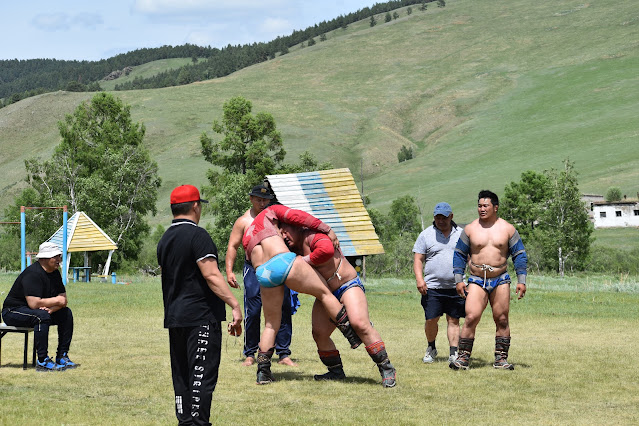Mongolia’s traditional nomadic culture is vanishing in many ways, but it is preserved and passed down through traditional wrestling, according to The Diplomat.
The
picture of nomadic herders living in gers and riding horses is one of the most
recognizable and well-known ones of Mongolia (yurt tent-houses). The other has
strong-built Mongolian wrestlers wearing traditional garb such a pointed
Mongolian cap, heavy-duty briefs, a red or blue zodog (open-chested shirt), and
wrestling boots. The nation's wrestling coaches are working to preserve
Mongolia's ancient culture as nomadism decreases.
Ulaanbaatar
first doesn't seem all that different from the capital cities of other former
Soviet satellite states. Along with big office buildings that contain banks and
mining businesses, there are chain coffee shops, private hospitals, and a stock
exchange. With a population of roughly 3 million, Mongolia boasts around 80
universities, including about 10 international university programs in business,
IT, and engineering. Less than an hour’s drive from the city limits, however,
the scenery explodes into breathtaking, rolling steppes of the deepest green,
dotted with gers and populated by families of herders.
It
takes a minimum of 100 to 200 animals to support a family. Historically,
Mongolian nomads moved four or more times per year, driving their flocks to
better grazing grounds. Throughout the year, they live in gers made of felt,
burning coal to survive temperatures as low as minus-50 degrees Celsius.
To
protect their animals from storms in the winter, they move them closer to the
mountains. Water must be hauled from rivers or wells, which may be up to one
mile away from the camp. For drinking water in the winter, ice is broken,
moved, and then heated.
A family in a ger uses 10 to 20
liters of water per day for drinking, cooking, and washing. The average shower
for a city-dweller, by contrast, utilizes 20 gallons (75 liters).
The herders’ day starts at 5 a.m.,
when teenage boys ride out to find the horses that were set loose for night
pasture. They herd the horses back to the corral, and begin the arduous task of
milking the mares. To kill time between milking cycles and other tasks, boys
wrestle. Most begin wrestling by the age of 5, and both boys and girls begin
riding horses as young as 3 or 4.
In the annual Naadam Festival, the
biggest holiday of the Mongolian calendar, children of both genders as young as
8 ride horses in a 15 km to 30 km point-to-point race.
Herders ride horses, or sometimes
motorcycles, nearly all day while herding and protecting their flocks. After
years in the saddle, they develop powerful thighs, double or triple the size of
city-dwellers.
The
majority of animal births occur during early spring and early summer,
throughout a busy two to three-month period. The foals and calves must then be
carefully monitored to make sure they eat enough and don't end up as food for
wolves and other predators.
In
the summer, the mothers must be milked—for cows, once or twice daily; for
horses, up to eight times daily. The mares must be wrestled and pinned before
being fitted with a halter in order to milk the horses. Some mares proceed
happily since they are accustomed to the milking cycle. Some need to be
restrained by three men or boys because they fight, making it difficult to bind
their feet. And this process could be multiplied by 40 or more mares, depending
on the size of the herd.
In
the spring, hair or wool is removed from the sheep, goats, camels, and yaks. In
the fall, animals are sold or slaughtered for food. Through a combination of
the sale of wool, cashmere, meat, and milk, a subsistence herder family
typically earns between $4,000 and $5,000 per year.
The
herder’s life is extremely hard work, and the economic payoff is small. It is
no wonder that over the past 20 years, the number of herders has steadily
declined. The number of animals is actually increasing – but this is because
big, commercial herding operations are replacing the small herders.
At
the same time, it seems that herding parents are recognizing the privations of
the nomadic life and are sending their children to the cities to attend school.
Due to increasing parental support for education, the dropout rate by age 14,
which was once extremely high, has declined to 1 percent. Nationwide, the high
school graduation rate is 94 percent for girls and 91 percent for boys, which
is only slightly lower than the U.S. which has a graduation rate of 94.5
percent.
Herder
families spend years’ worth of their income to send their children to
university, most of whom do not return. In some surveys, as many as 100 percent
of parents said that they wanted their children to remain in the city or go
abroad, seeking a better life, rather than returning to herding.
The transmission of traditional
culture is diminishing, as fewer parents want their children to become herders.
However, many still encourage their children to become wrestlers, and through
Mongolia’s wrestling coaches, the country’s ancient traditions and culture are
being passed on to a new generation.
Byambarenchin Bayaraa, wrestling
coach at the Mongolian National University of Education, explained that
wrestling continues to thrive alongside modernization, and that “Mongolians say
that they will make their children to be wrestlers.”
He went on to say that wrestling is
in Mongolians’ DNA. This sentiment was seconded by Budeebazar Adiyakhuu, coach
of Avarga Wrestling Club, who said: “The genes of Mongolians are different. We
still have that Mongol blood. So, we always like to wrestle, fight, struggle,
and compete.”
Wrestling is part of the culture of
Mongolia, according to Bayaraa, because wrestling is not a team sport. The
wrestler, like the nomadic herder, is independent. He is “not looking at the
teammates” and does not “need to ask anyone for strength or support.”
The coach of Nine Flags Wrestling
Club, Eruult Suhbaatar, highlights the strong lineage of wrestling in Mongolian
families, “Seventy percent of the wrestlers have some kind of family member who
is a wrestler, whether it was their grandfather or father. There is definitely
a connection with the ancestors.”
In addition to believing that
wrestling is a significant component of Mongol identity, the coaches also use
wrestling as a vehicle to convey traditional culture to young people. According
to Eruult, “There are morals that need to be taught. Even daily routines, such
as how to sleep and shower. A coach also teaches them to avoid alcohol, bars,
and violence.”
The relationship between the
wrestler and his coach is very similar to the relationship between a master and
an apprentice, according to Bayaraa. “In Mongolia, there is such a discipleship
that is formed between the coach and athlete, such a bond… which makes the
wrestler dedicate everything to his teacher: their body, language, mind,
everything.” In return for the students’ devotion, Bayaraa passes on wisdom
handed down for generations.
The ancestors “are smarter than I
am, because they have experienced both happiness and misery before me,” he
said. “So, I have to respect their age and intelligence.”
Traditional ethics are something
that Zaan Wrestling Club coach Amarbat Togtokhbayar teaches his wrestlers.
Considering that "just 1 out of 200 to 300 youngsters gets pro,"
there is undoubtedly discussion of values off the wrestling mat. He urges his
students to develop work skills because of this. "I want my pupils to take
their studies seriously in addition to wrestling in their lives. If not, they
will reach a dead end and be unable to pursue their studies or a career in
wrestling.
The ancient culture and values of
herding are taught to Mongolian youth less frequently today, although many
still learn them from their wrestling coaches. Most people won't go pro as
wrestlers. They'll eventually work as craftsmen, accountants, or computer
experts. Wrestling will be a fond memory of their formative years, and one that
leaves them with a deep appreciation of traditional culture, which they are
likely to pass on to their children, ensuring that Mongol culture will
continue.












0 Comments